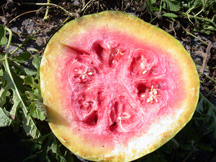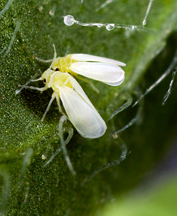
| RELATED INFO |
| * Southwest Purdue Agricultural Center |
| * USDA Sustainable Agriculture Research and Education |
| * USDA Agricultural Research Service |
| * Plant Disease, American Phytopathological Society |

April 6, 2007
Unusual appearance of watermelon virus in Indiana poses little threat
WEST LAFAYETTE, Ind. - |
The disease, squash vein yellowing virus, was found in a commercial watermelon field in Sullivan County in September 2006. It is the first time that the disease, carried by the approximately 1/16-inch whitefly, has been observed outside of Florida.
An article on the finding and virus identification by Dan Egel, a Purdue Extension plant pathologist in the Southwest Purdue Agricultural Center in Vincennes, Ind., is being published in the journal Plant Disease.
"Whiteflies are not normally agricultural pests in Indiana because they are a southern species," Egel said. "Winds can blow them up from the south. They feed on watermelon plants and pass the virus from plant to plant.
"Several strains of whitefly exist. The one that transmits squash vein yellowing virus is strain B. The common greenhouse whitefly has not been shown to be involved in the disease."
 |
The disease can cause vine collapse, plant wilt and root rot. In Florida, where the virus first appeared in 2002, the symptoms have included discoloration of the fruit.
Egel and Scott Adkins of the U.S. Department of Agriculture's Agricultural Research Service (USDA-ARS) in Fort Pierce, Fla., identified the disease found in Indiana as the squash virus through DNA analysis.
The whiteflies that carried the squash virus to the Hoosier state came late in the season. The disease caused moderate symptoms, which were restricted to one farm, Egel said. Because Indiana winters are cold, whiteflies can't survive over the winter.
"It's unlikely that this disease will become a major problem in Indiana since it's unusual for whiteflies to be here," Egel said. "If the whiteflies did return, it would likely be late in the season, too late to cause significant damage to the watermelon crop, and then the insects would die over the winter."
Similar diseases occur in Indiana, including mature watermelon vine decline, which appears to be caused by a soil-borne microorganism rather than an insect.
Growers should not be concerned about squash vein yellowing virus, but they should be aware of it and of mature watermelon vine decline. They also should be on the lookout for any symptoms so the problem can be diagnosed, Egel said.
"There are a lot of questions about both diseases," he said. "The main thing is we don't want producers to be alarmed. We want them to understand the differences in the diseases and to report any symptoms they encounter."
Egel is continuing to study watermelon diseases, focusing mainly on mature watermelon vine decline since it's found regularly in Indiana. The project is funded through a $98,500, three-year grant from the USDA Sustainable Agriculture Research and Education. Part of the research project includes a new Southwest-Purdue Agricultural Center research greenhouse, partially funded by the Illiana Watermelon Association and the National Watermelon Promotion BoardWriter: Susan A. Steeves, (765) 496-7481, ssteeves@purdue.edu
Source: Daniel Egel, (812) 886-0198, egel@purdue.edu
Ag Communications: (765) 494-2722;
Beth Forbes, forbes@purdue.edu
Agriculture News Page
To the News Service home page
If you have trouble accessing this page because of a disability, please contact Purdue News Service at purduenews@purdue.edu.
